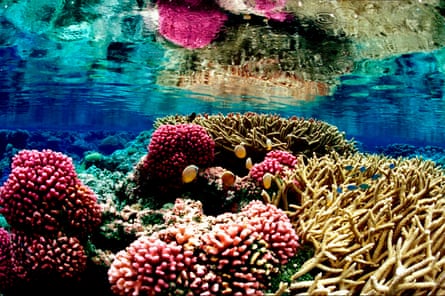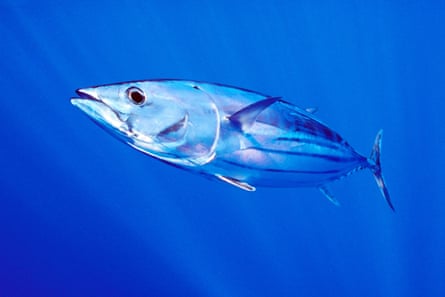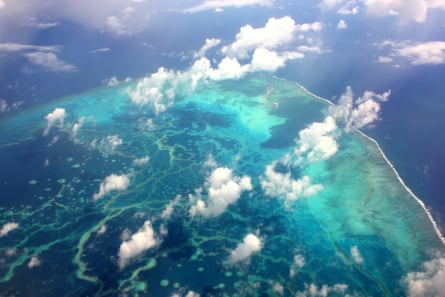This spring, longline commercial fishers petitioned the Trump administration to open up the Pacific marine monuments – some of the most biologically diverse marine conservation areas in the world, including Papahānaumokuākea. A World Heritage site, Hawaii’s Papahānaumokuākea constitutes 583,000 acres of protected waters, which host critically endangered species and important coral reef ecosystems.
These commercial fishers argued that “quick action is urgently needed” to meet “exceptionally high retail demand” for canned tuna as a result of the current pandemic – assertions which have been rebuked by many reports.
Overfishing in Hawaii is already prevalent, and important food fish species have declined by more than 75% across the populated Hawaiian Islands, according to a 2017 study by Dr Alan M Friedlander. The Honolulu Harbor is considered one of the top ports in America, bringing in an estimated $100m worth of landings annually. Longline fishers haul in yellowfin tuna, bigeye tuna, swordfish and lobster - the volume of which depletes the rich waters and reefs of Hawaii.
Nearly half of the state’s fish is exported, though the local demand for seafood is expected to increase by 40% in the next 20 years. When commercial fishers without ties to Hawaii deplete resources, it disrupts the local food system, creating food insecurity for low-income families and Native Hawaiians who depend on fish.

On the less populated islands like Moloka’i, 60-70% of residents are Native Hawaiians, and roughly 35% of the diet comes from subsistence fishing, gathering, hunting and farming, according to Dr Davianna Pōmaika’i McGregor, director of the University of Hawaii’s Center for Oral History. “It’s essential to honor the ethos of indigenous Hawaiians, which is to only take what you need. “Before there were freezers, the fish were left in the ocean until they were needed,” she says.
To whom do the deepwater and nearshore fish of Hawaii belong? And how should they be managed, especially as climate crisis events bleach reefs, imperiling critical habitat and the livelihoods of Native Hawaiians? Opening up protected waters would harm biodiversity and only further perpetuate the exploitation of Hawaii’s natural resources that began with the American occupation in 1893.
‘More loss will follow if we don’t act now’
Queen Lili’uokalani, Hawaii’s last sovereign monarch, first translated the Kumulipo – the Hawaiian creation narrative – into English in 1897 while imprisoned by the American forces that had overtaken her government.
Dr Ku’ulei Rodgers, a coral reef ecologist, tells me about how the indigenous relationship with nature is centered in Kumulipo. “The story talks about how the first two beings bring forth organisms in the order of importance,” she explains. “The first is the coral polyp, followed by the coral colony, then the marine creatures, then the terrestrials. The Native Hawaiians understood that their connection to the sea was absolutely vital to their lives. Life came from the sea, from coral.”
Today, Hawaii’s coral reefs are the cornerstone for marine conservation efforts, and are vulnerable to the climate crisis. Rodgers tells me: “We’re at a crossroads right now. What we do today is going to make the difference between when we have the reefs and when we don’t. It’s happening much quicker than what we thought. The data once said 2100, then 2050. Bleaching events were going to be 50- and 100-year events. Now bleaching events are predicted to happen every six years. These are severe enough to cause mortality. As temperatures rise, the coral reefs will suffer – more algae, less coral, less fish – and there will be a complete shift at the ecosystem level. You eventually won’t have coral reefs. The reefs are the canary in the coal mine. More loss will follow if we don’t act now.”

The core belief in the spiritual connection to the sea was undermined by people like Daniel Dole, who arrived in Hawaii in the 1840s as a missionary seeking to convert Native Hawaiians to Christianity. Dole was part of a western wave that decimated the Native Hawaiian population through disease exposure, and stole their land for business purposes. Dole’s grandson, James, started the Hawaiian Pineapple Company in 1901, and built it into the world’s largest fruit cannery.
These colonial land grabs resulted in the loss of Native resource management strategies. Westerners began managing traditional hunting grounds and sacred waters with a profit-first mentality, planting monocultures and building hotels. Prior to the pandemic, Hawaii was welcoming 10 million tourists a year.
This land grab mindset extends to modern fishing practices. “There’s a mentality among commercial fishers that it’s an open ocean and no one should be able to control you,” McGregor says. “Where’s the realization that unbridled harvesting practices have a huge impact on a community that relies on those resources for subsistence? For survival?”
“You don’t go into someone else’s place and take their resources, especially when they’re declining. You shouldn’t be coming to fish and gather unless it’s your responsibility to take care of the resources and practices where you live. Hawaiians are using the resources day to day - they know how to manage these resources best.”
‘Proper, just and appropriate – the ethical Hawaiian way’
Kevin Chang, co-director of Kua’āina Ulu ‘Auamo (KUA), an organization created to serve grassroots community stewardship networks, believes that more nearshore local community initiatives – in addition to continued protections at the federal level – are imperative to conservation success in Hawaii.
“A lot of people don’t know that Hawaii has traditions and values about how the environment should be managed,” he tells me. “If we were able to bring some of those concepts back into the way we care for Hawaii ,” he says, “we’d be doing a lot better.
“I think it’s generally understood that Native Hawaiians should have a say in the marine monument – many of our network community members are actively involved,” he says. “But the monument is also a place much bigger, and further from our reach, and may require more centralized governance approaches in decision-making, enforcement and monitoring.”
One strategy is to revive community-managed fishponds, known as Loko I‘a, which are historic aquaculture systems and an essential piece of the ahupua‘a, the traditional land stewardship system. Fishponds that have already been restored by Kua ‘Āina Ulu ‘Aumoa are thriving.
Areas where Native Hawaiians are able to manage fishing through traditional knowledge and practices are called community-based subsistence fishing areas (CBSFAs). The Hui Mālama O Mo’omomi draft proposal for the Mo’omomi Community Based Subsistence Fishing Area is currently up for approval, and would support a new CBSFA on the community of Moloka’i.

CBSFA procedures are built through “the lens of the Hawaiian value of aloha ‘āina, which emphasizes the connection between the environment and communities, whereby if you care for the land, the land will care for you”, according to government guidelines. Under the mentorship of Mac Poepoe, members of this community “observed the moon phases in relation to fish spawning cycles and developed a system by which to predict when selected fish species annually spawn along the north coast of Moloka’i”. This allows for compassionate and strategic harvesting of species like Pacific threadfin, parrotfish and hogfish. The proposal also mentions strategies for erosion control and the support of sea turtle nesting.
CBSFAs are respectful of natural cycles and focused on justice, but they are also effective. “There’s a clear pattern,” Rodgers says. “Data says community-based subsistence fishing areas work. 2016 and 2017 showed a substantial uptick in fish biomass at Hā’ena, the subsistence area on Kaua’i’s North End.”
There is growing support for indigenous resource management strategies. Organizations like the Office of Hawaiian Affairs ensure the Native Hawaiian perspective is included, if not elevated, in fishery policy-making.
“We’re also growing our own scientists, both Native and local,” Chang says. “In the past, conservation work was tied solely to a western way of looking at biology and ecosystems. In the past outside ‘experts’ weren’t connected to the communities they studied. It’s forgotten that expertise exists in the community itself.”
“We’ve been really progressing the Native Hawaiian voice in everything,” Kalani Quiocho says. “Things feel more collaborative, which is important given the injustices America has perpetuated on Hawaiians.” Quiocho coordinates NOAA’s management activities and strategies related to Native Hawaiian interests and cultural heritage management. “In my job, I think about how resource management can be conducted in a pono manner. Pono means proper, just, and appropriate – the ethical Hawaiian way.”
Quiocho once felt conflicted about using federal laws to protect Hawaii’s resources, and asked an elder why he cooperated. “This elder said that our sovereignty, and our health and wellbeing, is based on ’Āina, which is land, sea and all the extensions of these things that feed us. Our sanctuaries. The places we go to grieve and to celebrate. The North-Western Islands are ʻĀina. Our most sacred ʻĀina.”
“What is our sovereignty based on if ʻĀina is further defiled or destroyed? Our health and wellbeing? He told me to use the tools available now to secure the future our ancestors envisioned for us. We cannot wait for the Hawaiian government to be reinstated to protect ʻĀina. This is why I do what I do as a Native Hawaiian who works with the US government.”
I ask Quiocho what’s at risk if we fail to protect the waters surrounding Hawaii’s North-Western Islands. He pauses, then says: “Our lives. Not just our physical lives. The quality of our lives. Our identities. Our heritage. Native Hawaiians are so connected to our environment and ancestral places – the impacts to these places hurt us. These are parts of our shared human heritage.”
Restorative, indigenous practices are proven to produce and protect more fish. But more than that – allowing Native Hawaiians to manage the sacred grounds and natural resources our country illegally took from them – is a reparative action. It is pono.
The Link LonkAugust 26, 2020 at 04:47PM
https://ift.tt/2FVMgoB
'We're at a crossroads': who do the fish of Hawaii belong to? - The Guardian
https://ift.tt/35JkYuc
Fish
No comments:
Post a Comment